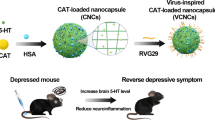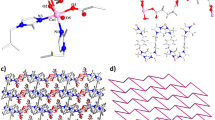Abstract
Coordination polymers have been a hot research topic in the field of biomedicine for their interesting bioactivities. To study the effects of metal ions on the bioactivity of the resulting coordination polymers, in this study, two novel coordination polymers, [Zn4(L)4(bix)4]·n(DMF)·4n(H2O) (1) and [Cd(L)(bix)(H2O)2]n·2n(H2O) (2) (H2L = 5-(1-oxoisoindolin-2-yl)isophthalic acid, bix = 5-(1-oxoisoindolin-2-yl)isophthalic acid, DMF = N,N′-dimethylformide), have been synthesized by the reactions of H2L, bix and Zn(II) or Cd(II) salts under the solvothermal condition and further characterized via the single crystal X-ray diffraction, powder X-ray diffraction, elemental analysis and thermogravimetric analyses. The CIE chromaticity diagram indicated that complexes 1 and 2 are excellent blue luminescent materials. Their therapeutic effect with synergistic curcumin on post-stroke depression was explored in the present work. First of all, the analysis of enzyme-linked immunosorbent assay was exploited for testing the 5-hydroxytryptamine (5-HT) content exists in brain. Next, the serotonin transporter relative expression was also analyzed with the detection of real-time reverse transcription-polymerase chain reaction (RT-PCR). The experimental results show that the CP 1 could be a better candidate for synergistic curcumin for treating post-stroke depression by increasing 5-HT content and relative expression of serotonin transporter than CP 2.







Similar content being viewed by others
Data availability
Selected bond lengths (Å) and angles (°) for 1–2 (Table S1); the detailed hydrogen bond parameters for 2 (Table S2); The PXRD patterns (a) for 1 and (b) for 2 (Fig. S1), the information could be found in the supporting information file.
References
Robinson RG, Jorge RE (2016) Post-stroke depression: a review. Am J Psychiatry 173:221–231
Medeiros GC, Roy D, Kontos N, Beach SR (2020) Post-stroke depression: a 2020 updated review. Gen Hosp Psychiatry 66:70–80
Zhang E, Liao P (2020) Brain-derived neurotrophic factor and post-stroke depression. J Neurosci Res 98:537–548
Qu XL, Yan B (2020) Cd-based metal-organic framework containing uncoordinated carbonyl groups as lanthanide postsynthetic modification sites and chemical sensing of diphenyl phosphate as a flame-retardant biomarker. Inorg Chem 59:15088–15100
Yang XM, Yan C, Li Z, Li X, Yu Q, Sang T, Gai Y, Zhang Q, Xiong K (2021) Viologen-based cationic metal-organic framework for efficient Cr2O72- adsorption and dye separation. Inorg Chem 60:5988–5995
Li Z, Cai W, Yang X, Zhou A, Zhu Y, Wang H, Zhou X, Xiong K, Zhang Q, Gai Y (2020) Cationic metal-organic frameworks based on linear zwitterionic ligands for Cr2O72- and ammonia sensing. Cryst Growth Des 20:3466–3473
Jarrah N, Troyano J, Carne-Sanchez A, Imaz I, Tangestaninejad S, Moghadam M, Maspoch D (2020) Dynamic porous coordination polymers built-up from flexible 4,4’-dithiodibenzoate and rigid N-based ligands. Dalt Trans 49:13142–13151
Zhang WF, Du Y, Sun XY, Pan HM, Ma YY, Li DY, Wu S, Yan TJ, Jing ZH (2021) Three-dimensional pillared-layer metal-organic framework based on single bifunctional organic ligand. Inorg Chem Commun 126:108469
Zhang H, Ji LQ, Song YZ, Kong ZG, Li C, Wang XY (2021) Syntheses, crystal structures and properties of Mn(II) and Co(II) coordination complexes based on 1,10-phenanthroline derivative. Chin J Struct Chem 40:336–342
Chahine AY, Turner DR, Batten SR (2021) Crystal engineering of coordination polymers using flexible tetracarboxylate linkers with embedded cyclohexyldiamine cores. CrystEngComm 23:569–590
Zhang X, Huang YY, Lin QP, Zhang J, Yao YG (2013) Using alkaline-earth metal ions to tune structural variations of 1,3,5-benzenetricarboxylate coordination polymers. Dalt Trans 42:2294–2301
Li JX, Du ZX, Xiong LY, Fu LL, Bo WB (2021) Supramolecular isomerism in two nickel(II) coordination polymers constructed with the flexible 2-carboxyphenoxyacetate linker: syntheses, structure analyses and magnetic properties. J Solid State Chem 293:121799
Li X, Yu Z, Guan T, Li X, Ma G, Guo X (2015) Substituent effects of isophthalate derivatives on the construction of Zinc(II) coordination polymers incorporating flexible bis(imidazolyl) ligands. Cryst Growtt Des 15:278–290
Zhang D, Bi C, Zong Z, Fan Y (2020) Three different Co(II) metal–organic frameworks based on 4,4’-bis(imidazolyl)diphenyl ether: syntheses, crystal structure and photocatalytic properties. J Inorg Organomet 30:5148–5156
Yang JX, Qin YY, Ye RP, Zhang X, Yao YG (2016) Employing mixed-ligand strategy to construct a series of luminescent Cd(II) compounds with structural diversities. CrystEngComm 18:8309–8320
Zhang Y, Fan J, Chen LZ, Geng HM (2020) Structural diversities of a series of Zn(II)/Cd(II) coordination polymers constructed via dual-ligand strategy of D-(+)-camphoric acid and pyridine -based ligand. J Mol Struct 1218:128482
Wang X, Xiao HY, Zhang MZ, Lin HY, Liu GC (2020) Four luminescent metal-organic chain compounds based on semi-rigid N-donor ligands and 3-hydroxy-2-naphthoic acid for recognition of Fe3+ and Cr2O72- ions. Polyhedron 179:114383
Yi FY, Dang S, Yang W, Su ZM (2013) Construction of porous Mn (II)-based metal–organic frameworks by flexible hexacarboxylic acid and rigid coligands. CrystEngComm 2013:8320–8329
Du M, Li CP, Liu CS, Fang SM (2013) Design and construction of coordination polymers with mixed-ligand synthetic strategy. Coord Chem Rev 257:1282–1305
Beheshti A, Bahrani-Pour M, Kolahi M, Shakerzadeh E, Motamedi H, Mayer P (2021) Synthesis, structural characterization, and density functional theory calculations of the two new Zn (II) complexes as antibacterial and anticancer agents with a neutral flexible tetradentate pyrazole-based ligand. Appl Organomet Chem 35:285–293
Chattopadhyay K, Datta S, Dhara S, Bertolasi V (2021) D Ray, exploration of varying coordination reactivity of Schiff base H3L toward Cd(II), Zn(II) and Mg(II): Hydroxido-bridged dimer, acetato-directed chain and live cell-imaging. Polyhedron 205:115288
Mukherjee S, Ganguly S, Manna K, Mondal S, Mahapatra S, Das D (2018) Green approach to synthesize crystalline nanoscale Zn II -coordination polymers: cell growth inhibition and immunofluorescence study. Inorg Chem 57:4050–4060
Suárez-García S, Solórzano R, Alibés R, Busqué F, Novio F, Ruiz-Molina D (2021) Antitumour activity of coordination polymer nanoparticles. Coord Chem Rev 441:213977
Gogoi A, Das A, Frontera A, Verma AK, Bhattacharyya MK (2019) Energetically significant unconventional π-π contacts involving fumarate in a novel coordination polymer of Zn(II): In-vitro anticancer evaluation and theoretical studies. Inorg Chim Acta 493:1–13
Karmakar T, Kuang Y, Neamati N, Baruah JB (2013) Cadmium complexes and cocrystals of indium complexes of benzothiazole derivatives and anticancer activities of the cadmium complexes. Polyhedron 54:285–293
Sheldrick GM (2015) Crystal structure refinement with SHELXL. Acta Crystallogr Sect C Struct Chem 71:3–8
van der Sluis P, Spek AL (1990) BYPASS: an effective method for the refinement of crystal structures containing disordered solvent regions. Acta Crystallogr Sect A Crystallogr 46:194–201
Zhang Y, Fan J, Chen LZ, Liu N, Geng HM (2020) Two new tetranuclear cluster-based coordination polymers based on isomorphic semi-rigid tetracarboxylate ligands: syntheses, structures, and luminescent properties. Z Anorg Allg Chem 646:1309–1314
Yang XF, Zhu HB, Liu M (2017) Transition-metal-based (Zn2+ and Cd2+) metal-organic frameworks as fluorescence “turn-off” sensors for highly sensitive and selective detection of hydrogen sulfide. Inorg Chim Acta 366:410–416
Yang JX, Qin YY, Cheng JK, Zhang X, Yao YG (2015) Construction of a series of Zn(II) compounds with different entangle motifs by varying flexible aliphatic dicarboxylic acids. Cryst Growth Des 15:2223–2234
Ye RP, Zhang X, Zhai JQ, Qin YY, Zhang L, Yao YG, Zhang J (2015) N-donor ligands enhancing luminescence properties of seven Zn/Cd(II) MOFs based on a large rigid π-conjugated carboxylate ligand. CrystEngComm 17:9155–9166
Ye RP, Zhang X, Zhang L, Zhang J, Yao YG (2016) Solvent and pH driven self-assembly of isomeric or isomorphic complexes: crystal structure and luminescent change upon desolvation. Cryst Growth Des 16:4012–4020
Funding
None.
Author information
Authors and Affiliations
Corresponding author
Ethics declarations
Conflict of interest
The author(s) declare(s) that there is no conflict of interest regarding the publication of this paper.
Additional information
Publisher's Note
Springer Nature remains neutral with regard to jurisdictional claims in published maps and institutional affiliations.
Supplementary Information
Below is the link to the electronic supplementary material.
Rights and permissions
Springer Nature or its licensor holds exclusive rights to this article under a publishing agreement with the author(s) or other rightsholder(s); author self-archiving of the accepted manuscript version of this article is solely governed by the terms of such publishing agreement and applicable law.
About this article
Cite this article
Zhao, X., Dong, Q., Ji, MY. et al. Two 3D supramolecular complexes: photoluminescent property and therapeutic effect with synergistic curcumin on post-stroke depression. Polym. Bull. 80, 7791–7803 (2023). https://doi.org/10.1007/s00289-022-04421-w
Received:
Revised:
Accepted:
Published:
Issue Date:
DOI: https://doi.org/10.1007/s00289-022-04421-w




